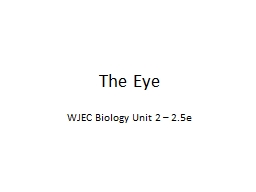

2 25e Structure of the Human Eye vitreous humour retina choroid sclera optic nerve ciliary muscle suspensory ligament cornea pupil aqueous humour iris lens Showhide arrows Showhide labels ID: 1037439
Download Presentation The PPT/PDF document "The Eye WJEC Biology Unit" is the property of its rightful owner. Permission is granted to download and print the materials on this web site for personal, non-commercial use only, and to display it on your personal computer provided you do not modify the materials and that you retain all copyright notices contained in the materials. By downloading content from our website, you accept the terms of this agreement.
1. The EyeWJEC Biology Unit 2 – 2.5e
2. Structure of the Human Eyevitreous humourretinachoroidscleraoptic nerveciliary musclesuspensory ligamentcorneapupilaqueous humouririslensShow/hide arrowsShow/hide labelsblind spotShow/hide blind spotNo colour
3. Task – you have one minute from the time the clock is started to remember as many of the names and locations of the structures that make up the eye… Start the clock
4. Can you now name the structures?Another minute12345678910111213
5. Blind spot testDraw a cross and a circle about 5 cm apart on a piece of paper. Hold the paper at arms length. Close your left eye and with your right eye focus on the ×. Then, slowly bring the paper closer to your eye. The circle will seem to “disappear”. This is your blind spot.5cm
6. Interesting facts…Eyesight provides the brain with more input than all the other senses combined!Each optic nerve contains one million nerve fibresIt is estimated that more than half the information in the conscious mind enters through the eyes.
7. Take a closer look at the eyeCows eyes are very similar to human eyes, just a bit bigger! So click on my eye to watch a dissection! Mooooooooo
8. Refractive errorswww.uniteforsight.orgIn normal sighted people things near and far appear in focuswww.uniteforsight.orgwww.uniteforsight.orgNear-sightednessFarsightednessClose up images like the chair are in focus, objects far away are blurry.Objects far away are in focus, but close up objects like the chairs are blurry
9. Near-sightednessThe eyeball is too long relative to the focussing power of the cornea and lens.Light rays are focused in front of the retina and the image is blurred. By putting spectacles with a concave lens, the light rays bend apart so that they are focused on the retina. RetinaLight raysConcave lens
10. FarsightednessThe eyeball is too short relative to the focussing power of the cornea and lens.Light rays are focused behind the retina and the image is blurred. By putting spectacles with a convex lens, the light rays bend together so that they are focused on the retina. RetinaLight raysConvex lens
11. AstigmatismThis is a combination of both near and farsightedness, making all objects blurrywww.uniteforsight.org